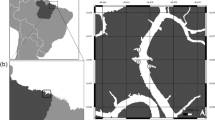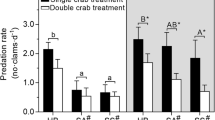Abstract
Rafting on floating objects is a common dispersal mechanism for many marine invertebrates. In order to identify adaptations to the rafting life style, we compared behavioural and metabolic characteristics of two isopods, the obligate rafter Idotea metallica and the facultative rafter Idotea baltica. In laboratory experiments, I. metallica showed low locomotive activity and a tight association to the substratum. Idotea baltica, in contrast, was more active with more frequent excursions in the surrounding water column. Oxygen consumption rates were similar in both species. Idotea metallica fed on zooplankton making this species widely independent of autochthonous food resources of the raft. Feeding rates and digestive enzyme activities were low in I. metallica. Reduced egestion rates may indicate slow gut passage and, thus, efficient resorption of nutrients. Efficient food utilization and the ability to accumulate high amounts of storage products, i.e. lipids, indicate a possible adaptation of I. metallica to low food availability or starvation. The feeding behaviour of I. baltica, in contrast, was more herbivorous and appeared wasteful and inefficient. Low lipid contents in I. baltica also indicate poor storage reserves. Thus, I. baltica requires a permanent access to food.






Similar content being viewed by others
References
Abelló P, Guerao G, Codina M (2004) Distribution of the neustonic isopod Idotea metallica in relation to shelf-slope frontal structures. J Crust Biol 24:558–566
Aliani S, Molcard A (2003) Hitch-hiking on floating marine debris: macrobenthic species in the Western Mediterranean Sea. Hydrobiologia 503:59–67
Biesiot PM, Wang SY, Perry HM, Trigg C (1999) Organic reserves in the midgut gland and fat body of the giant deep-sea isopod Bathynomus giganteus. J Crust Biol 19:450–458
Boehlert GW, Yoklavich MM (1984) Carbon assimilation as a function of ingestion rate in larval pacific herring, Clupea harengus pallasi Valenciennes. J Exp Mar Biol Ecol 79:251–262
Bulnheim H-P (1974) Respiratory metabolism of Idotea balthica (Crustacea, Isopoda) in relation to environmental variables, acclimation process and moulting. Helgoländer Meeresunters 26:464–480
Cheng L (1975) Marine pleuston—animals at the sea-air interface. Oceanogr Mar Biol 13:181–212
Fox HM, Simmonds BG (1933) Metabolic rates of aquatic arthropods from different salinities. J Exp Biol 10:67–78
Franke H-D, Gutow L, Janke M (1999) The recent arrival of the oceanic isopod Idotea metallica Bosc off Helgoland (German Bight, North Sea): an indication of a warming trend in the North Sea? Helgoländer Meeresunters 52:347–357
Franke H-D, Janke M (1998) Mechanisms and consequences of intra- and interspecific interference competition in Idotea baltica (Pallas) and Idotea emarginata (Fabricius) (Crustacea: Isopoda): a laboratory study of possible proximate causes of habitat segregation. J Exp Mar Biol Ecol 227:1–21
Grasshoff K (1983) Determination of oxygen. In: Grasshoff K, Ehrhardt M, Kremling K (eds) Methods of seawater analysis. Verlag Chemie, Weinheim, pp 61–72
Gutow L (2003) Local population persistence as a pre-condition for large-scale dispersal of Idotea metallica (Crustacea, Isopoda) on drifting habitat patches. Hydrobiologia 503:59–67
Gutow L, Franke H-D (2001) On the current and possible future status of the neustonic isopod Idotea metallica Bosc in the North Sea: a laboratory study. J Sea Res 45:37–44
Gutow L, Franke H-D (2003) Metapopulation structure of the marine isopod Idotea metallica, a species associated with drifting habitat patches. Helgoland Mar Res 56:259–264
Hagen W, Auel H (2001) Seasonal adaptations and the role of lipids in oceanic zooplankton. Zoology 104:313–326
Hartmann J (1976) Der Jahresgang von Neuston im Golf von Neapel. Int Rev Ges Hydrobio 61:825–840
Hemmi A, Jormalainen V (2002) Nutrient enhancement increases performance of a marine herbivore via quality of its food algae. Ecology 83:1052–1064
Herring PJ (1969) Pigmentation and carotinoid metabolism of the marine isopod Idotea metallica. J Mar Biol Assoc UK 49:766–779
Ingólfsson A (1995) Floating clumps of seaweed around Iceland: natural microcosms and a means of dispersal for shore fauna. Mar Biol 122:13–21
Ingólfsson A (2000) Colonization of floating seaweed by pelagic and subtidal benthic animals in southwestern Iceland. Hydrobiologia 440:181–189
Jones MB (1973) Survival and oxygen consumption in various salinities of three species of Idotea (Crustacea, Isopoda) from different habitats. Comp Biochem Physiol 48A:501–506
Jones DA, Kumlu M, Le Vay L, Fletcher DJ (1997) The digestive physiology of herbivorous, omnivorous and carnivorous crustacean larvae: a review. Aquaculture 155:285–295
Korczynski RE (1989) Biochemical composition of the isopod Mesidotea entomon (Linnaeus) from the western Arctic. Polar Biol 9:391–395
Kurmaly K, Yule AB, Jones DA (1989) An energy budget for the larvae of Penaeus monodon (Fabricius). Aquaculture 81:13–25
Le Vay L, Jones DA, Puello-Cruz AC, Sangha RS, Ngamphongsai C (2001) Digestion in relation to feeding strategies exhibited by crustacean larvae. Comp Biochem Physiol 128A:623–630
Longhurst A, Sathyendranath S, Platt T, Caverhill C (1995) An estimate of global primary production in the ocean from satellite radiometer data. J Plankton Res 17:1245–1271
Miller MA (1968) Isopoda and Tanaidacea from buoys in coastal waters of the continental United States, Hawaii, and the Bahamas (Crustacea). Proc US Nat Mus 125:1–53
Moreira PS (1972) Species of marine Isopoda (Crustacea, Peracarida) from Southern Brazil. Bolm Inst Oceanogr S Paulo 21:163–179
Morris BF, Mogelberg DD (1973) Identification manual to the pelagic Sargassum fauna. Bermuda Biol Stat Spec Publ 11:1–63
Naylor E (1972) British Marine Isopods. Linn Soc Synopsis of the British Fauna (new series) No. 3. Academic, London
Saborowski R, Buchholz F (1996) Annual changes in the nutritive state of North Sea dab. J Fish Biol 49:173–194
Sano M, Omori M, Taniguchi K (2003) Predator-prey systems of drifting seaweed communities off the Tohoku coast, northern Japan, as determined by feeding habitat analysis of phytal animals. Fish Sci 69:260–268
Strong KW, Daborn GR (1979) Growth and energy utilisation of the intertidal isopod Idotea baltica (Pallas) (Crustacea: Isopoda). J Exp Mar Biol Ecol 41:101–123
Thiel M, Gutow L (2005a) The ecology of rafting in the marine environment. II. The rafting organisms and community. Oceanogr Mar Biol 43:279–418
Thiel M, Gutow L (2005b) The ecology of rafting in the marine environment. I. The floating substrata. Oceanogr Mar Biol 42:181–263
Thiel M, Hinojosa I, Vasquez N, Macaya E (2003) Floating marine debris in coastal waters of the SE-Pacific (Chile). Mar Poll Bull 46:224–231
Tully O, Ó Céidigh P (1986) The ecology of Idotea species (Isopoda) and Gammarus locusta (Amphipoda) on surface driftweed in Galway Bay (West of Ireland). J Mar Biol Assoc UK 66:931–942
van der Baan SM, Holthuis LB (1969) On the occurrence of Isopoda in the surface plankton in the North Sea near the lightship “Texel”. Neth J Sea Res 4:354–363
Vetter R-A, Franke H-D, Buchholz F (1999) Habitat-related differences in the responses to oxygen deficiencies in Idotea baltica and Idotea emarginata (Isopoda, Crustacea). J Exp Mar Biol Ecol 239:259–272
Zöllner N, Kirsch K (1962) Über die quantitative Bestimmung von Lipoiden (Mikromethode) mittels der vielen natürlichen Lipoiden (allen bekannten Plasmalipoiden) gemeinsamen Sulphophosphovanillin-Reaktion. Z Gesamte Exp Med 135:545–561
Author information
Authors and Affiliations
Corresponding author
Additional information
Communicated by O. Kinne, Oldendorf/Luhe
Rights and permissions
About this article
Cite this article
Gutow, L., Strahl, J., Wiencke, C. et al. Behavioural and metabolic adaptations of marine isopods to the rafting life style. Mar Biol 149, 821–828 (2006). https://doi.org/10.1007/s00227-006-0257-9
Received:
Accepted:
Published:
Issue Date:
DOI: https://doi.org/10.1007/s00227-006-0257-9




